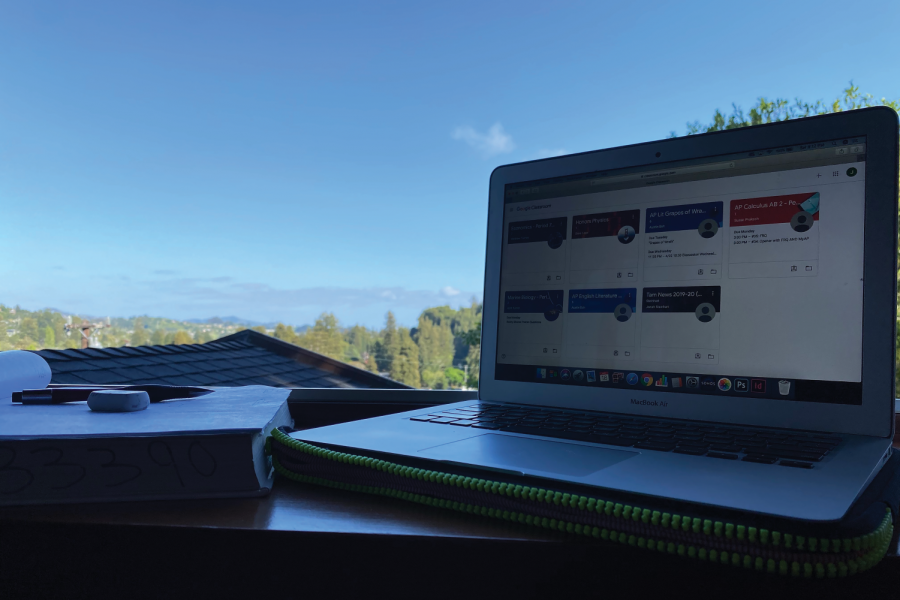Tam tackles distance learning
Apr 16, 2020
Grace Gustafson, Johanna Meezan, and Quinn Rothwell contributed additional reporting.
The distance learning plan
Following the closure of school campuses on March 13, students began to receive instruction and assignments online from their teachers. The district laid out a plan for remote learning in an email on March 12, directing teachers to email assignments to students through EschoolPLUS.
However, in response to an announcement that schools would remain closed until May 1, the district presented a revised plan on April 3 introducing a schedule more reminiscent of one on a school campus. Students are now required to do the classwork of a particular class during the time that class is scheduled to meet.
Teachers now must hold class meetings once per week over Zoom, Google Meet, or “online discussion boards such as Google Classroom or Google Docs” during the time that class is scheduled to meet. According to superintendent Tara Taupier, the decision to move to a set schedule was motivated by a district survey of student opinions on distance learning.
“Students were running into conflicts with teachers holding live sessions at the same time and not necessarily following the regular schedule,” Taupier said in an email.
Ensuring internet access
To allow all students to participate in online instruction during the campus closures, the district provided digital devices and hotspot internet connections for students who requested aid.
Sophomore Ben Hasen received a computer from the school following the closures.
“My photo teacher dropped it off at my house … the teachers are making a good effort to make sure every kid can do the work they need and it really shows how much they care about their students,” Hasen said.
However, as of March 29, 25 Tam students who need internet access had not received a hotspot, according to principal J.C. Farr.
“We are looking into other options to support students, such as purchasing hot-spots through phone carriers,” Farr said in an email.
Reactions to the plan
Teachers, students, and administration are facing a variety of challenges adjusting to online learning.
Many teachers are uncertain of how to assess students academically and emotionally.
“So much of how I teach is based on how I see students responding and seeing what they want and need. I feel like I’m just assigning work into a void,” history teacher Jennifer Dolan said. “I wish I could know more about what my students needed. Are they bored? Do they need structure? Are they anxious and overwhelmed? How do you teach the same stuff to students who are all experiencing different things?”
Other students and teachers have reported having similar difficulties communicating.
“Some of my teachers definitely have [distance learning] down and just send us a to-do list every day, but some teachers have been just posting random assignments which makes it really confusing,” senior Elliot Pavis said.
“I struggled with how to give feedback to students. Email is not ideal in terms of explaining math concepts and writing out equations,” math teacher Rebecca Henn said. “To fix this, I bought an iPad with a stylus, in which I can now write comments on students’ work as I would on paper. Fortunately, this cost was partially offset by using my teacher expense reimbursement allowance that is made available to all teachers by the Tam High Foundation.”
Teachers have used a wide variety of online resources — including Google Classroom, email, and personal websites — to convey instruction, which has proven to be frustrating to some students.
“I think that everything is a little confusing. Due dates are everywhere. All of my teachers combined use about three different platforms to assign homework,” freshman Cam Croley said.
Although the district originally directed teachers to email students assignments through EschoolPLUS, they later requested that teachers use Google Classroom to give out work. Henn originally used email and her website to assign work and then moved to Google Classroom.
“I want to minimize the number of times I change my procedures for my students, since this adds more confusion to my students’ lives as they are already trying to understand a new system for each of their classes,” Henn said. “However, as time proceeds, I am continually getting more information about the expectations for me as a teacher from our district, in addition to getting daily feedback from students … It feels like designing a plane while flying.”
Many individuals commented on the emotional toll of distance learning and the coronavirus pandemic.
“The loss of that vibrant community that was full of personality, and humor, and angst, and wonder, and closeness of three-dimensional people is the saddest part of not teaching in person at school,” science teacher David Lapp said. “One of the ways that I’ve tried to build community (or at least try to preserve a bit of it) is to hold Zoom workouts. I’ve done two so far and they’ve been a lot of fun. It’s as much about getting together outside of learning as it is about trying to avoid being too sedentary.”
Some teachers are hopeful that the new schedule from the district will reintroduce routine into their lives.
“I plan to make [the mandatory Zoom classes] close in style to what my in-the-classroom style is, which will hopefully make [students] look forward to that bit of remembered normalcy,” Lapp said.
Students have varying opinions about the shift to a formal schedule.
“Honestly, for me, I like having no schedule better. I’m able to manage my time, spend time with my family, and also do work … but I do agree with the [district’s] goal to have maybe a little more structure,” junior Phoebe Greathouse said.




